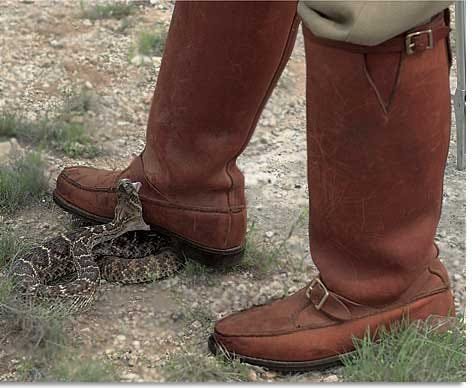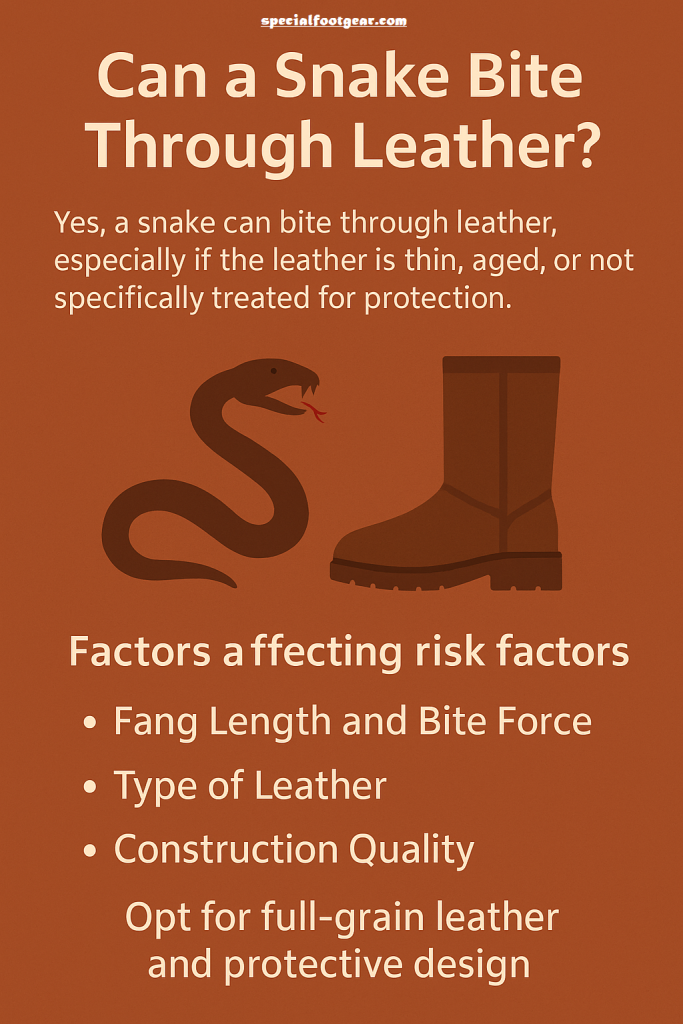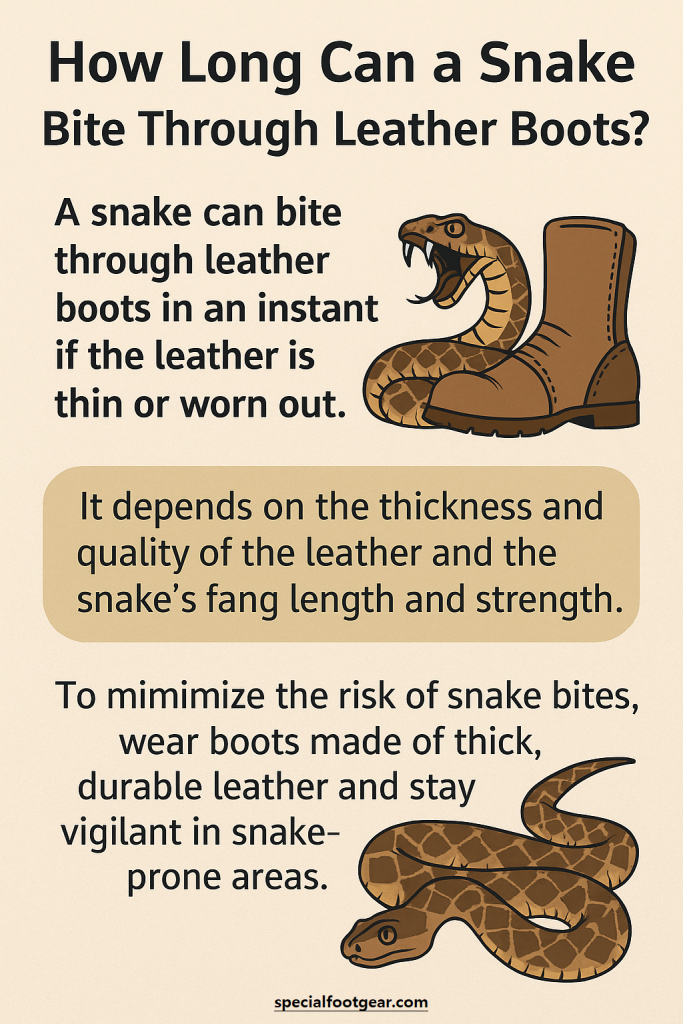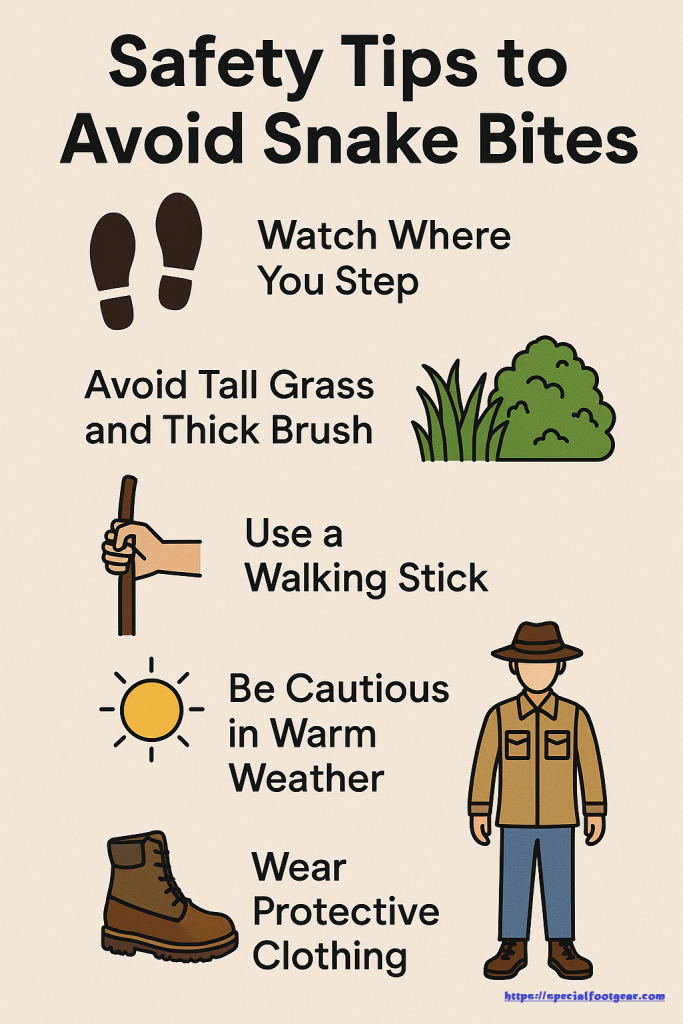A snake can bite through leather boots, but it’s uncommon. The thickness and type of leather play a crucial role.
Snakes pose a risk to hikers and outdoor enthusiasts. Leather boots offer some protection against snake bites. Not all leather boots are created equal.
Thick, high-quality leather provides better defense. Thin or worn leather might not stop a snake’s fangs.
It’s essential to choose sturdy boots for outdoor activities. Snakes can strike quickly, aiming for warmth. Ankles and lower legs are common targets. Leather boots cover these vulnerable areas. Investing in durable boots enhances safety.
Always stay vigilant in snake-prone areas. Proper gear and awareness reduce bite risks.

Credit: www.youtube.com
Anatomy Of A Snake Bite
Understanding the anatomy of a snake bite is crucial for evaluating risks. Snakes have evolved to be efficient predators. Their bites are designed to immobilize prey quickly. Let’s delve into the details.
Fang Structure
Snake fangs are specialized teeth. They are long, hollow, and sharp. The fangs pierce skin easily. They can even penetrate some materials. The length of the fangs varies by species. Some snakes have fangs that retract. Others have fixed fangs. This feature helps in efficient venom delivery.
Fang Structure Table:
| Snake Type | Fang Length | Fang Type |
|---|---|---|
| Viper | Up to 2 inches | Hinged |
| Cobra | Up to 1 inch | Fixed |
| Rattlesnake | Up to 1.5 inches | Hinged |
Venom Injection
The process of venom injection is swift. Once the fangs pierce the skin, venom glands release toxins. The venom travels through the hollow fangs. It enters the wound immediately. Venom types vary among species. Some snakes use neurotoxins. Others use hemotoxins.
Venom has multiple purposes. It immobilizes the prey. It also starts digesting it. This dual function is essential for survival. A snake bite is not always venomous. Some bites are dry, meaning no venom is injected.
Key Points on Venom Injection:
- Immediate venom release
- Different venom types
- Dual function: immobilization and digestion
- Possibility of dry bites

Credit: www.youtube.com
Types Of Leather Boots
Understanding the different types of leather boots can help determine their effectiveness against snake bites. Each type varies in material quality and construction techniques, impacting their durability and protection level.
Material Quality
Leather boots come in various material qualities. The most common types include:
- Full-Grain Leather: The highest quality leather. It is durable and tough.
- Top-Grain Leather: Slightly lower quality than full-grain. It is still strong and flexible.
- Genuine Leather: Made from the leftover layers. It is less durable.
- Bonded Leather: Made from leather scraps. It is the least durable.
Full-grain leather offers the best protection. Its dense fibers make it hard for snake fangs to penetrate. Top-grain leather also provides good protection, but not as much as full-grain. Genuine leather and bonded leather offer the least protection.
Construction Techniques
The construction of leather boots affects their ability to withstand snake bites. Key construction techniques include:
| Technique | Description |
|---|---|
| Goodyear Welt | A durable stitching method. It creates a strong bond between the sole and the boot. |
| Blake Stitch | A single stitch method. It is flexible but less durable than Goodyear Welt. |
| Cementing | The sole is glued to the upper. It is the least durable method. |
Goodyear Welt construction offers the best protection against snake bites. The stitching method creates a robust barrier. Blake Stitch provides moderate protection, while cementing offers the least.
Choosing the right type of leather boots involves understanding both material quality and construction techniques. Prioritize full-grain leather and Goodyear Welt construction for maximum safety.
Testing Leather Boots
Many people wonder, can a snake bite through leather boots? To answer this, rigorous testing is essential. We will explore both laboratory tests and real-world scenarios to understand the effectiveness of leather boots against snake bites.
Laboratory Tests
Laboratory tests help assess the strength and durability of leather boots. Scientists use special equipment to mimic snake bites. These tests measure the force and pressure a snake bite exerts.
In one study, researchers used a mechanical snake head to bite different boot materials. They measured the depth of the puncture and checked for penetration. Leather boots often showed resilience, but results varied based on leather thickness and quality.
The table below shows the results from one such test:
| Boot Material | Puncture Depth (mm) | Penetration |
|---|---|---|
| Thin Leather | 5 | Yes |
| Thick Leather | 2 | No |
| Reinforced Leather | 1 | No |
These tests show that thicker and reinforced leather provides better protection.
Real-world Scenarios
Laboratory tests are controlled, but real-world scenarios tell a different story. In the wild, snakes strike with varying force and angles.
Many hikers and farmers wear leather boots. They report mixed experiences with snake bites. Some boots prevent penetration, while others do not. The boot’s design and the snake’s type also play roles.
For instance, a hiker in Texas shared his experience. He wore reinforced leather boots and survived a rattlesnake bite without injury. His boots showed bite marks but no penetration.
Another case involved a farmer in Australia. He wore thin leather boots and suffered a snake bite. The snake’s fangs penetrated through, causing injury.
- Thick leather offers better protection.
- Reinforced leather is the best option.
- Boot design and snake type matter.
In conclusion, while leather boots can offer some protection, the material and design significantly impact effectiveness. Always opt for thicker or reinforced leather for better safety against snake bites.

Credit: www.reddit.com
Factors Influencing Snake Bites
Understanding the factors influencing snake bites is crucial. These factors determine if a snake can bite through leather boots. Let’s explore the key elements.
Snake Species
The type of snake plays a significant role. Some snakes have more powerful bites. For example, the rattlesnake and cobra have strong jaws. They can penetrate tougher materials. Other snakes like the garter snake have weaker bites. They might not be able to bite through leather.
Bite Force
Bite force varies greatly between different snake species. Some have a bite force strong enough to pierce leather boots. Let’s look at a comparison:
| Snake Species | Bite Force (psi) |
|---|---|
| Rattlesnake | 150 psi |
| Cobra | 200 psi |
| Garter Snake | 50 psi |
From the table, it’s clear. Stronger bite forces mean a higher chance of biting through leather.
- Rattlesnakes and cobras have high bite forces.
- Garter snakes have lower bite forces.
Therefore, understanding snake species and bite force is essential. These factors determine the risk of a snake bite penetrating leather boots.
Protective Gear Comparison
Choosing the right protective gear can make a huge difference. Especially if you are in snake-prone areas. This section will help you compare leather boots and synthetic materials. It will also cover additional safety features.
Leather Vs. Synthetic Materials
Both leather and synthetic materials are commonly used in protective boots. Each has its own advantages and limitations.
| Feature | Leather Boots | Synthetic Boots |
|---|---|---|
| Durability | Very durable and long-lasting | Durable but less than leather |
| Flexibility | More flexible and comfortable | Less flexible, can be stiff |
| Protection | Thick leather offers good protection | High-tech materials can be puncture-proof |
| Weight | Heavier than synthetic | Lighter and easier to wear |
Additional Safety Features
Besides the material, additional features enhance the safety of boots.
- Reinforced Toes: Extra protection against bites and impacts.
- Steel Shank: Provides additional strength and protection.
- Waterproofing: Keeps feet dry in wet conditions.
- High Ankles: Prevents bites to the lower leg.
These features add extra layers of security. They make the boots more effective against snake bites.
Case Studies
Can a snake bite through leather boots? This question often concerns outdoor enthusiasts. Understanding real-life incidents and expert opinions can shed light on this matter. Let’s delve into some case studies.
Documented Incidents
Several documented incidents highlight snake encounters with leather boots. These incidents provide valuable insights into the effectiveness of leather boots against snake bites.
| Incident | Details |
|---|---|
| Hiker in Texas | A hiker reported a rattlesnake bite on his leather boots. The bite did not penetrate the leather. |
| Camper in Australia | A camper’s leather boots were bitten by a venomous snake. The boots prevented the venom from reaching the skin. |
Expert Opinions
Medical and wildlife experts agree that while leather boots can offer a degree of protection, they are not entirely snake-proof—especially against large or aggressive species.
According to Johns Hopkins Medicine, wearing thick leather boots and long pants is advised when walking in tall grass or snake-prone environments. They note that while these can reduce the risk, no footwear can guarantee complete protection from venomous snake bites.
The Centers for Disease Control and Prevention (CDC) also recommend wearing high, sturdy boots and thick clothing as a preventative measure when working or hiking in areas with venomous snakes (CDC Snake Bite Prevention Guide).
Practical Advice
Snakes are fascinating yet potentially dangerous creatures. If you love the outdoors, you might worry about snake bites. This section offers practical advice on staying safe from snake bites, especially through leather boots.

Credit: handyhomeboss.medium.com
Choosing The Right Boots
Not all leather boots are equal in snake protection. Quality matters when picking the right pair. Look for boots with thick, durable leather. Consider boots designed specifically for snake protection. These often have extra layers of material.
Here’s what to look for in snake-proof boots:
- Thick leather or other tough materials
- High tops that cover your calves
- Reinforced soles for added protection
| Feature | Importance |
|---|---|
| Thick Leather | Prevents snake fangs from penetrating |
| High Tops | Protects your calves |
| Reinforced Soles | Offers additional safety |
Can Snake Bite Through Leather?
Yes, a snake can bite through leather, particularly if the leather is thin, aged, or not specifically treated for protection. While leather is known for its durability and resilience, it’s still a natural material—animal hide—and not immune to the sharp puncture of a determined snake fang.
The risk of penetration largely depends on a few key factors:

- Fang Length and Bite Force: Some venomous snakes, like rattlesnakes or cobras, have fangs up to 2 inches long and deliver bite forces exceeding 200 psi. That kind of power can push through soft or lightly constructed leather with surprising ease.
- Type of Leather Used: Not all leather is created equal. Full-grain leather—which retains the strongest outer layer of hide—is much tougher than bonded or genuine leather, which are made from leftover or lower layers. The denser the leather fibers, the more resistance it offers.
- Construction Quality: The way a boot is put together also matters. Stitched leather, especially when done with a Goodyear welt or similar method, offers more integrity than glued or cemented construction, which may tear or split under pressure.
To reduce the risk of a snake bite penetrating your boots, it’s wise to invest in full-grain leather boots that are specifically designed for outdoor protection, often labeled as snake-resistant. These may include added materials like kevlar or puncture-resistant inserts, reinforcing vulnerable spots like the ankles and lower calves.
In short, while leather can offer some degree of protection, especially when thick and well-constructed, it’s not foolproof. When venturing into snake-prone terrain, don’t assume that any leather will keep you safe—choose boots engineered to do so.
How Long Can A Snake Bite Through Leather Boots?
The duration of a snake bite isn’t measured in time but in force and penetration. Snakes strike incredibly fast—often in under a second. Whether a snake can bite through leather boots depends on the leather’s thickness, density, and condition at the moment of contact.

If the leather is thin or worn, even a brief strike can result in penetration. However, thick, high-quality leather boots—especially those reinforced for outdoor use—can often withstand the bite of many snake species. This makes them a critical line of defense for hikers and field workers.
Key takeaway: A snake doesn’t need time—it needs an opportunity. If you’re in snake-prone areas, ensure your boots are tough enough to take a hit instantly.
Can Snakes Bite Through Muck Boots?
Muck boots are a popular choice for those working or walking in wet, muddy, or marshy environments. Made from materials like flexible rubber and neoprene, these boots are valued for their waterproof qualities, warmth, and comfort. But when it comes to snake protection, they aren’t as reliable as you might think.
While muck boots offer a barrier thicker than typical shoes, they are not specifically engineered to resist snake fangs. A venomous snake—particularly an aggressive species like a rattlesnake or copperhead—can still penetrate the softer outer layers of muck boots if it strikes with enough force and precision. The key issue is that rubber and neoprene, although durable, don’t have the densely woven or layered resistance needed to reliably block a strong snake bite.
This means that while muck boots may slow or deflect a weak bite, they cannot be trusted as full protection in high-risk snake zones.
For those spending time in snake-prone areas—such as farmers, hunters, or outdoor workers—it’s best to enhance your safety with:
- Snake gaiters worn over the boots
- Snake-proof socks or liners
- Or choosing snake-proof boots designed and tested to withstand fang penetration
So, can snakes bite through muck boots? Yes, they can. And while the boots may reduce the severity of a bite in some cases, they are not a guaranteed form of protection. Always prioritize specialized gear when snake safety is a concern.
Can Copperheads Bite Through Leather Boots?
Copperheads are venomous pit vipers with moderate fang length and strength. While their bite isn’t as forceful as a rattlesnake’s, a copperhead can bite through leather boots—particularly if the boots are made from thin leather or not designed for protective wear.
Their average fang length is around 0.5 to 1 inch, which is enough to pierce soft or untreated leather. If you’re in an area known for copperhead activity, it’s wise to wear boots tested for snake resistance.
Can Snake Bite Through Shoes?
Ordinary shoes, especially sneakers, running shoes, or low-cut hiking shoes, offer little to no protection from snake bites. These shoes are typically made from fabric, mesh, or thin synthetic materials—easy for sharp fangs to puncture.
Even some low-cut leather shoes might not provide enough coverage or protection. For environments with high snake activity, avoid wearing any footwear that exposes your ankles or lacks structural strength.
Bottom line: When asking “Can a snake bite through leather boots?”, the better question is—are your boots built for it?
Safety Tips to Prevent Snake Bites
Wearing the right boots is only part of staying safe in snake territory. Awareness and smart habits are equally important. Here are some essential safety tips to reduce your risk of snake bites:

👣 Watch Where You Step
Always keep your eyes on the trail. Snakes often blend into dry leaves, rocks, or dirt paths, making them hard to spot. Step carefully and avoid putting your feet or hands where you can’t see.
🌿 Avoid Tall Grass and Thick Brush
Snakes love to hide in dense vegetation. Stick to clear, well-trodden paths. Avoid walking through tall grass, piles of leaves, or fallen logs without checking first.
🪵 Use a Walking Stick
Tapping the ground ahead of you with a walking stick sends vibrations that can scare snakes away before you get too close. It also helps you check hidden spots safely.
☀️ Be Cautious in Warm Weather
Snakes are more active during warm seasons, especially in early morning and late afternoon. This is when they’re likely to be out sunning themselves or hunting.
🥾 Wear Protective Clothing
In addition to snake-resistant boots, wear long pants made of thick material. Tuck your pants into your boots or gaiters to minimize exposed skin.
📵 Stay Alert, Not Distracted
Avoid distractions like phones or music while walking in snake-prone areas. Stay aware of your surroundings and listen for rustling or warning rattles.
🧭 Learn Local Snake Behavior
Familiarize yourself with the types of snakes in your region, their habitats, and peak activity times. Knowledge is one of the best tools for prevention.
Frequently Asked Questions
- Can Snakes Bite Through Leather Boots?
Yes, some snakes can bite through thin leather boots.
- Are Leather Boots Snake-proof?
Most leather boots are not fully snake-proof.
- What Snakes Can Penetrate Leather Boots?
Large venomous snakes like rattlesnakes can penetrate thin leather.
- How To Choose Snake-resistant Boots?
Look for boots made from thick, durable materials.
- Do Leather Boots Offer Any Protection?
Leather boots offer some protection but are not foolproof.
Conclusion
Understanding the reality behind the question—can a snake bite through leather boots—is essential for anyone spending time outdoors. While leather boots do offer a layer of defense, especially when made from thick, high-quality materials, they are not entirely foolproof. Snake fangs, especially from large or aggressive species, can pierce untreated or worn leather with surprising ease.
To reduce risk, always opt for full-grain leather boots with reinforced construction, particularly those labeled as snake-resistant. But remember—no boot guarantees 100% protection. Combining proper gear with situational awareness and smart choices in snake-prone environments is your best defense.
So, can a snake bite through leather boots? In some cases, yes—but with the right boots and cautious behavior, you can greatly lower the danger and walk safer outdoors.
Recent Posts
Neuropathy socks have open toes to enhance breathability and comfort for individuals with sensitive feet. This design allows for better airflow, reducing moisture and irritation. Neuropathy can...
Soothing Solutions: How To Warm Up Cold Feet From Neuropathy?
To warm up cold feet from neuropathy, try soaking them in warm water or using heated socks. Gentle foot massages also help improve circulation. Cold feet can be a common issue for individuals with...
